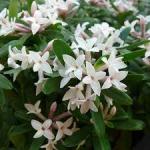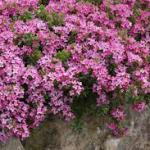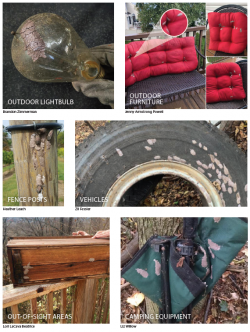A monthly e-newsletter from UMass Extension for landscapers, arborists, and other Green Industry professionals, including monthly tips for home gardeners.
To read individual sections of the message, click on the section headings below to expand the content:
Hot Topics
Ask The Entomologist!
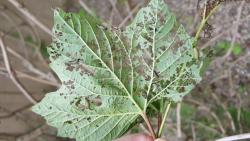 Ask UMass Extension Entomologist Tawny Simisky your questions about early season and invasive insect and mite pests of trees and shrubs! Participants will have the opportunity in advance to rank the following topics in order of importance to them on the identification and management of: fall and spring cankerworms, oak lecanium scale, viburnum leaf beetle, spruce spider mite, emerald ash borer, and spotted lanternfly. Ask the Entomologist will be hosted live via Zoom, enabling participants to speak with Ms. Simisky in real time.
Ask UMass Extension Entomologist Tawny Simisky your questions about early season and invasive insect and mite pests of trees and shrubs! Participants will have the opportunity in advance to rank the following topics in order of importance to them on the identification and management of: fall and spring cankerworms, oak lecanium scale, viburnum leaf beetle, spruce spider mite, emerald ash borer, and spotted lanternfly. Ask the Entomologist will be hosted live via Zoom, enabling participants to speak with Ms. Simisky in real time.
The first hour will cover the topics the audience ranked as most important. Participants will also be asked to submit specific questions on these topics beforehand. At the end there will be a guided Q&A/discussion session. For best results, registered participants are asked to submit their priority topics and questions at least 1 week before April 22.
Register early as space is limited to 25 participants! For more details and registration options, go to https://ag.umass.edu/landscape/events/ask-entomologist.
Tawny Simisky, Extension Entomologist, UMass Extension Landscape, Nursery, & Urban Forestry Program
Featured Plant
Shrubs for Fragrance
The loss of the sense of smell was certainly a relatively minor loss suffered by many over this past year, but its absence and return have won it a new appreciation by those who experienced this unfortunate effect of the Coronavirus. If you were among the many who lost this sense, you will appreciate the temporary nature of this loss and will, perhaps, find ways to bring more desirable fragrances into your life. In gardens, the scent of certain plants can transport us back to times and places long ago – for many the scent of lilacs (Syringa vulgaris), mock-orange (Philadelphus coronarius) or peonies (Paeonia lactiflora) bring a flood of childhood memories and a nostalgic longing.
More than just a fleeting pleasure for humans, these floral fragrances are designed to attract pollinators. They are often a complex mix of volatile compounds which combine to create distinctive scents emitted from petals and other plant parts. The scents are distinctive to each flower and broadcast the location of nectar and pollen (though some plants provide scent with no such reward). The fragrance helps guide pollinators to a particular plant. Sweet scents, particularly those that are emitted during the day, are most attractive to bees and butterflies. Moths and bats are the target species for evening blooming flowers like moonflowers (Ipomoea alba), four o’clocks (Mirabilis jalapa) and flowering tobacco (Nicotiana sylvestris) whose fragrance is highest during the hours those pollinators are active. Foul smelling flowers, like skunk cabbage (Symplocarus foetidus), attract particular flies and bees. To conserve their resources, many plants are fragrant only prior to pollination, losing their scent once the work of the pollinator is done. Warm temperatures often bring scent molecules wafting on warm breezes. Plants like witch hazel (Hamamelis sp.) that are open very early or late in the season are dependent on warmth for their petals to unfurl and for the fragrance to heighten. These are especially important for pollinators on the extreme ends of the growing season, when little else is in bloom. So fragrances, while especially appreciated by human noses, have a much more important function in the life of plants and pollinators.
If you have a newfound appreciation for your sense of smell, here are a few deliciously fragrant plants, you might consider adding to your landscape.
Daphne’s are classic fragrant shrubs, but also have a reputation for being difficult to grow. Here are three that will endure:
- Daphne x transatlantica is a modest size shrub, reaching 3’ tall with a similar width and holding leaves some years, particularly in protected locations. The most exuberant bloom occurs in May when clusters of pale pink buds open to white flowers with a delightful fragrance. Cultivars include Eternal Fragrance (‘Blafra’), and the lightly variegated ‘Summer Ice’.
- Garland flower (Daphne cneorum) is a low-growing evergreen shrub that works well in a rock garden or raised bed. It requires sharp drainage, full sun, and protection from harsh winter winds, but given these requirements it will last for decades and brighten late April and early May with ruby pink flowers with a spicy fragrance. The fine foliage is a mere 1” long and quite narrow; leaves remains deep green all year round.
- February Daphne (Daphne mezereum) is actually more likely to bloom in April in most of our region, but in this changing climate earlier flowers are not unknown. The straight species reaches 3’ tall, drops its leaves in winter, and holds fattened buds along the light tan stems. As the weather warms in spring, the buds swell and crack, finally opening to reveal lavender-pink flowers with a strong, sweet perfume. A white variant, Daphne mezereum forma alba, is equally lovely.
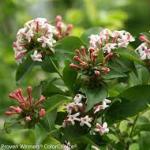 Later in May, fragrant or Korean abelia (Abelia mosanensis) makes its appearance, adding a sweet fragrance to the spring air. Pink buds open to white flowers after the leaves have unfurled. This 4-6’ tall arching shrub blooms best in full sun, but is also tolerant of partial shade. Reddish-orange fall foliage is an added bonus.
Later in May, fragrant or Korean abelia (Abelia mosanensis) makes its appearance, adding a sweet fragrance to the spring air. Pink buds open to white flowers after the leaves have unfurled. This 4-6’ tall arching shrub blooms best in full sun, but is also tolerant of partial shade. Reddish-orange fall foliage is an added bonus.
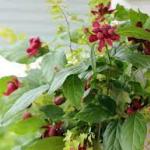 Hybrid sweetshrubs (Calycanthus cvs) combine the lovely fragrance of our native Calycanthus floridus with that of an Asian species, Calycanthus sinensis. Of the resulting cultivars, ‘Aphrodite’ seems to bear the best fragrance. Ruby flowers of 12 or more petals occur throughout the growing season over glossy 3-6” long leaves. Some liken the scent of the flowers to apples, or describe it as fruity. This 8’x6’ shrub will give you ample time to decide how best to describe the scent as its flowers stud the plant throughout the entire summer season. Best growth is achieved when you give this shrub rich, organic soil in full sun or partial shade.
Hybrid sweetshrubs (Calycanthus cvs) combine the lovely fragrance of our native Calycanthus floridus with that of an Asian species, Calycanthus sinensis. Of the resulting cultivars, ‘Aphrodite’ seems to bear the best fragrance. Ruby flowers of 12 or more petals occur throughout the growing season over glossy 3-6” long leaves. Some liken the scent of the flowers to apples, or describe it as fruity. This 8’x6’ shrub will give you ample time to decide how best to describe the scent as its flowers stud the plant throughout the entire summer season. Best growth is achieved when you give this shrub rich, organic soil in full sun or partial shade.
![]() Seven-son flower (Heptacodium miconiodes) brings clouds of fragrant white flowers backed by lasting ruby calyxes in September and early October. This large shrub or small tree can be grown as a multi-stemmed or as a single-stemmed specimen and will reach up to 20’ tall and 10-15’ wide. Hailing from China, this beautiful shrub enjoys an organic, well-drained garden soil in full sun or part-shade. Its late season flowers are a magnet for pollinators, including monarch butterflies who are lured in by its gleaming white flowers and sweet fragrance. Trunks and branches sport peeling tan bark, making this an interesting plant even in the winter months.
Seven-son flower (Heptacodium miconiodes) brings clouds of fragrant white flowers backed by lasting ruby calyxes in September and early October. This large shrub or small tree can be grown as a multi-stemmed or as a single-stemmed specimen and will reach up to 20’ tall and 10-15’ wide. Hailing from China, this beautiful shrub enjoys an organic, well-drained garden soil in full sun or part-shade. Its late season flowers are a magnet for pollinators, including monarch butterflies who are lured in by its gleaming white flowers and sweet fragrance. Trunks and branches sport peeling tan bark, making this an interesting plant even in the winter months.
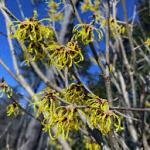 Cap off your growing season with our own native witchhazel (Hamamelis virginiana), which winds down the season with soft yellow flowers amid yellow fall foliage in October and November, and this past year, well into December. This 10-20’ tall, arching understory shrub grows in moist rich soils and provides the last floral repast for native pollinators like flies, native bees and wasps.
Cap off your growing season with our own native witchhazel (Hamamelis virginiana), which winds down the season with soft yellow flowers amid yellow fall foliage in October and November, and this past year, well into December. This 10-20’ tall, arching understory shrub grows in moist rich soils and provides the last floral repast for native pollinators like flies, native bees and wasps.
One last note - some fragrances are reduced when plants are damaged, stressed or nutrients are not a optimal levels, so if fragrance is your thing, grow your plants well for best results!
Joann Vieira, Director of Horticulture, Trustees
Questions & Answers
Q. I have a small home orchard with apples, pears, peaches and plums. So far, I have not had much luck harvesting edible fruit. Can you provide me with a basic spray schedule for a home fruit orchard?
A. While there is nothing like the satisfaction and quality of harvesting fruit from a home orchard, it is important to realize that tree fruits are not fail proof. Tree fruits require realistic expectations, considerable expertise and time. Realistic expectations in a home orchard should include the possibility of more failures than successes. Expertise is needed not only to manage the fruit trees but also to identify and manage pests. Tree fruits take time; management and monitoring of fruit trees require attention year round and pest management often requires precise timing to be successful.
Tree fruits have a large number of potential pests. For many of the common tree fruits (apples, pears, and peaches), this amounts to dozens of possible pests. While some pests are more common than others, successful pest management requires knowing what specific pests are present in the home orchard. Without knowing the specific pests present, a spray schedule is difficult to recommend. Specific pests vary by fruit type, location, and site-specific conditions.
Integrated Pest Management (IPM) is a holistic approach to pest management. IPM uses a series of science-based steps to help make informed management decisions. The steps of IPM can help a home orchardist organize the information by which an informed management plan and spray schedule for the home orchard can be created.
The first step in IPM is proper identification. The pest must be correctly identified to implement the proper management strategy. With such a large number of potential insect and disease pests, correct identification of a problem can be a challenge. An example of the importance of proper identification in apples is the problem of wormy fruit. Wormy fruit can be caused by several pests including plum curculio, codling moth, and apple maggot. While these pests can cause wormy fruit, expertise is needed to recognize the specific insect causing the damage. Once properly identified, the insect’s biology can be researched and the timing of management strategies identified.
The second step of IPM is monitoring. Monitoring includes a regular checking of the plants and requires both time and expertise. Time must be dedicated to the careful observation and expertise is required to know what, where and when to look for specific pests. Monitoring often includes the use of traps. The red sticky sphere used in apples is a good example. This trap is used to monitor apple maggot activity, which informs the timing of control tactics.
The third step is knowing thresholds. A threshold is the point at which a pest population reaches an intolerable level. Different pests have different thresholds. Some pests, such as plum curculio and apple maggot, have low thresholds because these pests cause injury that results in crop losses, while other problems such as the diseases sooty blotch and fly speck are often tolerated in the home orchard. These diseases blemish fruit and commercially the blemishes would make them unmarketable, but in the home orchard blemishes can be tolerated. In the home orchard, realistic expectations should include fruit that have blemishes.
The fourth step is control tactics. Control tactics include the management options implemented to keep a pest from reaching an intolerable level. IPM focuses on using cultural and biological controls and relying on pesticides only when absolutely necessary. In the home orchard, cultural control aspects include using disease resistant cultivars and keeping fruit trees healthy and stress free. Biological control often focuses on promoting beneficial insects by providing habitat and resources such as a pollinator garden. Unfortunately, many of the pests that attack fruit trees can not be managed successfully with just cultural and biological controls. Therefore, pesticides are often needed. When choosing a pesticide, choose the least toxic material that will do the job and be safe for beneficial insects. Be aware that pesticides often require precise timing to be effective and timing is often based on tree phenology.
Keep detailed records. The information you collect will be the information that will enable you to create a spray schedule specific to the pests you have in your home orchard.
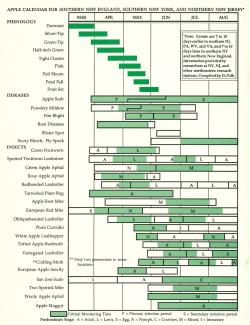 Apple Calendar for Southern New England, Southern New York, and Northern New Jersey
Apple Calendar for Southern New England, Southern New York, and Northern New Jersey
Copied from Management Guide for Low-Input Sustainable Apple Production, a publication of the United States Department of Agriculture Northeast Low-Input Sustainable Agriculture Apple Production Project and Cornell University, Rodale Research Center, Rutgers University, University of Massachusetts, and University of Vermont.
Other useful resources
Russ Norton, Agriculture & Horticulture Extension Educator, Cape Cod Cooperative Extension
Trouble Maker of the Month
Spotting Spotted Lanternfly Egg Masses in the Spring
Spotted lanternfly (Lycorma delicatula, “SLF”), a sap-feeding pest recently introduced to the US, has become an invasive insect of great concern in New England. While its main host plant is the non-native tree of heaven, SLF attacks over 103 other host plants, including agricultural crops like grapes, apples, and hops, and hardwood trees such as maple and black walnut. An established infestation of this invasive pest would cause serious economic and environmental damage to the region with agriculture, forestry, and the timber industries potentially affected.
Spotted lanternflies produce a single generation each year, with adults dying off with the first hard frost. That means that, at this time of year, only their egg masses remain and will not hatch until May. It is recommended that you search for egg masses in early spring, to catch them before they hatch.
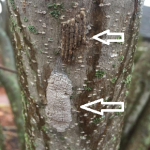 Female spotted lanternflies lay one or two egg masses per generation, with 30 to 50 eggs in each mass. The masses are usually covered in a protective coating that looks like a waxy putty, starting out white when fresh and later drying to resemble a gray, cracked, patch of mud. This rough gray covering works well as a camouflage on many surfaces, including tree bark, rocks, and weathered wood. Any exposed or uncovered eggs will resemble strings of connected seeds.
Female spotted lanternflies lay one or two egg masses per generation, with 30 to 50 eggs in each mass. The masses are usually covered in a protective coating that looks like a waxy putty, starting out white when fresh and later drying to resemble a gray, cracked, patch of mud. This rough gray covering works well as a camouflage on many surfaces, including tree bark, rocks, and weathered wood. Any exposed or uncovered eggs will resemble strings of connected seeds.
Unfortunately, female spotted lanternflies don’t just lay their eggs on tree trunks and other natural materials, but on nearly any flat surface, including vehicles, shipping containers, pallets of crushed stone and other hardscaping material, or outdoor furniture and decorations. This means there is a big risk of egg masses being accidentally introduced on vehicles or goods that are imported from infested states. For a more complete list of items that could harbor SLF eggs, download the Mass. Department of Agricultural Resources' (MDAR) Best Management Practices for Nurseries and Landscapers.
Green industry workers, arborists, and landscapers serve as an important first line of defense against the introduction and spread of spotted lanternfly. Use the images below to learn what SLF egg masses look like, and report anything suspicious that you find!
SLF egg masses have been found on some unusual items, not just trees, as these photos from Pennsylvania show:
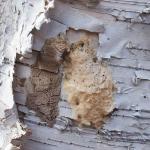 When you are on the lookout for SLF egg masses, the most common look-alikes you will likely encounter in this region are the egg masses of the gypsy moth (Lymantria dispar). Gypsy moth egg masses can be found from late August through May on almost any vertical surface. They can be distinguished from SLF egg masses by their buff or yellowish fuzzy coating, and often have tiny pinprick holes on the surface, evidence of parasitic wasp activity. The eggs themselves, which can be seen by scraping away the fuzzy covering, are small and spherical, compared to the larger and more oval eggs of lanternflies.
When you are on the lookout for SLF egg masses, the most common look-alikes you will likely encounter in this region are the egg masses of the gypsy moth (Lymantria dispar). Gypsy moth egg masses can be found from late August through May on almost any vertical surface. They can be distinguished from SLF egg masses by their buff or yellowish fuzzy coating, and often have tiny pinprick holes on the surface, evidence of parasitic wasp activity. The eggs themselves, which can be seen by scraping away the fuzzy covering, are small and spherical, compared to the larger and more oval eggs of lanternflies.
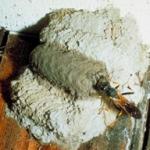 You may also come across mud wasp or mud dauber nests on the sides of structures or under roof overhangs. Mud daubers are solitary wasps and are a native insect that create cylinders of mud to house their eggs. The shape and large size set them apart from SLF egg masses:
You may also come across mud wasp or mud dauber nests on the sides of structures or under roof overhangs. Mud daubers are solitary wasps and are a native insect that create cylinders of mud to house their eggs. The shape and large size set them apart from SLF egg masses:
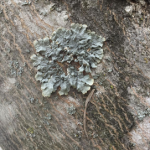 Lichens may also sometimes be confused with SLF egg masses, especially from far away. But lichens are actually a hybrid growth of algae and fungus that can be found in many habitats. They have a wide variety of appearances but are commonly scaly-looking and flat, with a bluish-green tinge. These are harmless, naturally-occurring organisms and should be left alone. However, SLF egg masses could be camouflaged amongst a lichen-covered surface, so you should always check to make sure!
Lichens may also sometimes be confused with SLF egg masses, especially from far away. But lichens are actually a hybrid growth of algae and fungus that can be found in many habitats. They have a wide variety of appearances but are commonly scaly-looking and flat, with a bluish-green tinge. These are harmless, naturally-occurring organisms and should be left alone. However, SLF egg masses could be camouflaged amongst a lichen-covered surface, so you should always check to make sure!
If you think you have found a spotted lanternfly egg mass, please photograph what you see and report it here. If you are not able to take a photograph, you can scrape the eggs off using a plastic ID card from the Massachusetts Department of Agricultural Resources (MDAR) or a credit card, place them in a bag or other sealable container, and add rubbing alcohol as soon as you can - this will kill the eggs. Report any suspected egg masses you've gathered in this way to MDAR using the same reporting form, and retain them in case MDAR requests to see them.
If you download MDAR's Best Management Practices for Nurseries and Landscapers for your own reference, keep in mind that you can also print them out to distribute to customers or other colleagues in the field. You can also print out MDAR's mini-poster for display and order ID cards to distribute here.
Joshua Bruckner, Forest Pest Outreach Coordinator, Massachusetts Department of Agricultural Resources
Garden Clippings Tips of the Month
April is the time to:
-
Thin seedlings that are becoming crowded. This is best accomplished by using clean scissors to snip off unwanted stems at soil level rather than pulling them. Pulling seedlings can disturb fragile roots of remaining seedlings. When remaining seedlings are ready for transplanting to larger containers, hold them by the leaves, not the stem. Fungi that cause damping-off disease can be spread by touching seedling stems.
-
Prune roses. Start by cutting back to the base all canes that are dead, damaged, or thin and weak looking. On hybrid tea, grandiflora, and floribunda types, remove all but 3 to 5 of the remaining canes. Then prune these back to a height of 15 to 18 inches, making sure the cut is just above an outward facing bud. Modern shrub roses need less intensive pruning; just thin out a third of the oldest canes by cutting them back to the base.
-
Dig and divide perennials as soon as their new shoots appear—the earlier, the better. Most perennials will benefit from division every 3 to 5 years in order to rejuvenate plants and ensure abundant blooms from year to year. When dividing older perennials, discard the center of each clump and replant sections from the outer areas where shoots are more vigorous.
-
Look for lily leaf beetle, a ¼-inch long, black-legged, bright red insect that feeds voraciously on leaves of true lily species (e.g. Asiatic lily, tiger lily, Turk’s cap lily), fritillaria, and occasionally lily-of-the-valley, Solomon’s seal, hollyhocks, and hosta. Though adults can be hand-picked, applications of the natural pesticide neem at weekly intervals may be more effective. Neem repels the adult beetles and kills the slug-like larvae.
-
Check houseplants growing near windows to make sure they are not getting sunburned. Most tropical houseplants prefer low light conditions. Now that sunlight is more intense as the sun rises higher in the sky, vulnerable plants should be shaded or moved away from windows.
-
Start seeds of tomatoes indoors a month and a half to two months prior to last frost. Studies have shown that 6- to 8-week-old tomato transplants provide the best growth and highest fruit yields. Later in April, sow cucumbers, melons, and squash. Starting these large, fast-growing seedlings in peat pots makes for easier transplanting outdoors after the frost-free date for your area.
-
Keep off the lawn as much as possible until the ground dries, at which point rake off dead grass and other debris that has accumulated. Sharpen mower blades in preparation for the first lawn cutting and keep blades sharp through the growing season. Dull blades shred grass rather than cut it, causing the lawn to have a ragged, brownish look and can make it more vulnerable to disease.
-
Use floating row covers to moderate weather conditions over transplants in the vegetable garden. These reusable, lightweight fabric sheets transmit a percentage of sunlight and allow passage of water and air. They protect tender plants from light frosts, drying winds, and garden pests, and also help to warm cool spring soils.
-
Allow the leaves of daffodils to die back naturally after the plants have finished blooming, since the leaves generate food for the plants. Resist the temptation to tidy the appearance of the loose, floppy foliage by tying or braiding. The plants need as much exposed leaf area as possible to photosynthesize enough energy to replenish the bulb for next year’s flowers.
-
Engage garden-minded students at home with fun agricultural projects, apps, interactive maps, and videos through the U.S. Department of Agriculture’s new AgLab website.
Jennifer Kujawski, Horticulturist
Have You Seen Me? Chances are you have…
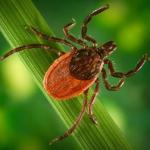 It’s spring, time to get outside as a respite from pandemic-induced cabin fever. At this time I am asked the age old question, “When is tick season?” My simple answer is that it never really stopped. These adult stage deer ticks as pictured began emerging last September and will be with us until early May. Any time temperatures are above freezing, they are ready to make you their dinner. What assists them in this amazing trick is that they make their own antifreeze. I receive calls from people during the winter saying that they never expected to get tick bites at that time.
It’s spring, time to get outside as a respite from pandemic-induced cabin fever. At this time I am asked the age old question, “When is tick season?” My simple answer is that it never really stopped. These adult stage deer ticks as pictured began emerging last September and will be with us until early May. Any time temperatures are above freezing, they are ready to make you their dinner. What assists them in this amazing trick is that they make their own antifreeze. I receive calls from people during the winter saying that they never expected to get tick bites at that time.
This is reflected in the case data shown in the chart below. We see cases of Lyme disease in January, February and March. Then, as we get into the warmer months of May into July, we see cases ramp up significantly (MA Dept. Public Health).
There are a couple of reasons for this. There is a lot more outdoor activity by people, and therefore more opportunities to bump into these unwanted creatures. Also, during May is when we see the emergence of the nymph stage of the deer tick. These are the size of a POPPY SEED…small enough to easily evade a tick check.
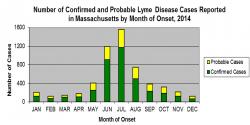 And it’s not just about Lyme disease anymore. Other significant diseases are babesiosis and anaplasmosis. We also see a certain level of co-infection where ticks are carrying more than one pathogen.
And it’s not just about Lyme disease anymore. Other significant diseases are babesiosis and anaplasmosis. We also see a certain level of co-infection where ticks are carrying more than one pathogen.
People ask me, what should we do, stay inside? We have had too much experience with indoor confinement! A personal protection plan is very straightforward. When you are in tick habitat, which could be in the woods or at the edge of your backyard, wearing light color long pants and shoes (versus sandals) is a start. When you come back indoors, do a thorough tick check and throw the clothes in the dryer for 20 minutes.
Repellents are important…skin repellents like DEET or picaridin are known to be effective. The Centers for Disease Control and Prevention also recommend products containing oil of lemon eucalyptus (OLE); however these products should not be used on children under 3 years old. Avoid “all natural” products…in many cases, there is no testing that shows they are safe or effective. For more information from the CDC, please visit https://www.cdc.gov/ncezid/dvbd/about/prevent-bites.html. The state of Massachusetts also provides more information at https://www.mass.gov/service-details/personal-protection-against-ticks.
From my standpoint, the most effective tool in the box is permethrin-treated clothing and footwear. It not only repels but actually kills the ticks. You can find such products at garden centers and sporting goods stores. For a video on the ins and outs of permethrin, part of a ten part series from Cape Cod Cooperative Extension, go to Capecodextension.org/ticks.
Enjoy the outdoors and stay tick safe.
Larry Dapsis, Entomologist, Tick Project Coordinator, Cape Cod Cooperative Extension
Upcoming Events
For more details for any of these events, go to the UMass Extension Landscape, Nursery, and Urban Forestry Program Upcoming Events Page.
-
Apr 7 - Glyphosate 411 Weedinar
Credits: 3 pesticide contact hours available for all private categories, 33, 36, 37, 39, 40, Dealer, and Applicators License (core) available. Association credits: 2.5 ISA, 1 MCA, 1 MCLP, and 1 MCH available. Full details at: https://ag.umass.edu/landscape/events/weedinar-glyphosate-411-0 -
Apr 22 - Ask The Entomologist
Registration limited to 25 participants.
Credits: 1 pesticide contact hour available for categories 29, 35, 36, 48 and Applicators (core) license. Association credits: 1 ISA, .5 MCA Education Credit, .5 MCLP Education Credit, and 1 MCH credit available. Full details at: https://ag.umass.edu/landscape/events/ask-entomologist
Pesticide Exam Preparation and Recertification Courses
These workshops are currently being offered online. Contact Natalia Clifton at nclifton@umass.edu or go to https://www.umass.edu/pested for more info.
InsectXaminer!
Episodes so far featuring gypsy moth, lily leaf beetle, euonymus caterpillar, and imported willow leaf beetle can be found at: https://ag.umass.edu/landscape/education-events/insectxaminer
TickTalk with TickReport Webinars
To view recordings of past webinars in this series, go to: https://ag.umass.edu/landscape/education-events/ticktalk-with-tickreport-webinars
Additional Resources
For detailed reports on growing conditions and pest activity – Check out the Landscape Message
For professional turf managers - Check out our Turf Management Updates
For commercial growers of greenhouse crops and flowers - Check out the New England Greenhouse Update website
For home gardeners and garden retailers - Check out our home lawn and garden resources. UMass Extension also has a Twitter feed that provides timely, daily gardening tips, sunrise and sunset times to home gardeners at twitter.com/UMassGardenClip
Diagnostic Services
Landscape and Turf Problem Diagnostics - The UMass Plant Diagnostic Lab is accepting plant disease, insect pest and invasive plant/weed samples (mail-in only - walk-in samples cannot be accepted). The lab serves commercial landscape contractors, turf managers, arborists, nurseries and other green industry professionals. It provides woody plant and turf disease analysis, woody plant and turf insect identification, turfgrass identification, weed identification, and offers a report of pest management strategies that are research based, economically sound and environmentally appropriate for the situation. Accurate diagnosis for a turf or landscape problem can often eliminate or reduce the need for pesticide use. See our website for instructions on sample submission and for a sample submission form at https://ag.umass.edu/services/plant-diagnostics-laboratory. Mail delivery services and staffing have been altered due to the pandemic, so please allow for some additional time for samples to arrive at the lab and undergo the diagnostic process.
Soil and Plant Nutrient Testing - The UMass Soil and Plant Nutrient Testing Lab is accepting orders for routine soil analysis and particle size analysis ONLY (please do not send orders for other types of analyses at this time). Send orders via USPS, UPS, FedEx or other private carrier (hand delivered orders cannot be accepted at this time). Processing time may be longer than usual since the lab is operating with reduced staff and staggered shifts. The lab provides test results and recommendations that lead to the wise and economical use of soils and soil amendments. For updates and order forms, visit the UMass Soil and Plant Nutrient Testing Laboratory web site.
Tick Testing - The UMass Laboratory of Medical Zoology is unable to accept samples for tick testing at this time. The UMass Center for Agriculture, Food, and the Environment provides a list of potential tick identification and testing alternatives here: https://ag.umass.edu/resources/tick-testing-resources.
